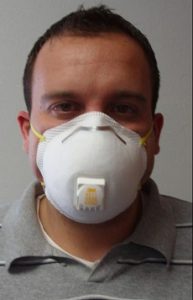
COVID-19 has raised the question… is the OSHA respirator fit test and medical exam required for nursery and landscape workers voluntarily wearing masks to protect themselves from the coronavirus? The answer is NO, if the masks or respirators are voluntarily worn and are not required under the Worker Protection Standard, or OSHA requirements for pesticide or chemical application exposure, and fall into the following:
- A filtering face-piece disposable paper-type dust respirators
- An air supplied positive pressure face mask, unless intended for rescue or emergency purposes
- An air supplied positive pressure hood, unless intended for rescue or emergency purposes
However, an elastomeric respirator that is being voluntarily worn, and is not required as indicated above does not need a fit test under OSHA rules, but does require a medical evaluation for the worker. The following link is to an OSHA respirator video describing different types of respirators. The description of an elastomeric respirator begins at 6 minutes, 48 seconds into the video.
Additionally, if these respirators are voluntarily worn, and are not required as outlined above, then from Appendix D to Section 1910.134 (Mandatory) Information for Employees Using Respirators When Not Required Under the Standard, the following must be communicated to workers:
- Respirators are an effective method of protection against designated hazards when properly selected and worn. Respirator use is encouraged, even when exposures are below the exposure limit, to provide an additional level of comfort and protection for workers. However, if a respirator is used improperly or not kept clean, the respirator itself can become a hazard to the worker. Sometimes, workers may wear respirators to avoid exposures to hazards, even if the amount of hazardous substance does not exceed the limits set by OSHA standards. If your employer provides respirators for your voluntary use, or if you provide your own respirator, you need to take certain precautions to be sure that the respirator itself does not present a hazard.
- Read and heed all instructions provided by the manufacturer on use, maintenance, cleaning and care, and warnings regarding the respirators limitations.
- Choose respirators certified for use to protect against the contaminant of concern. NIOSH, the National Institute for Occupational Safety and Health of the U.S. Department of Health and Human Services, certifies respirators. A label or statement of certification should appear on the respirator or respirator packaging. It will tell you what the respirator is designed for and how much it will protect you.
- Do not wear your respirator into atmospheres containing contaminants for which your respirator is not designed to protect against. For example, a respirator designed to filter dust particles will not protect you against gases, vapors, or very small solid particles of fumes or smoke.
- Keep track of your respirator so that you do not mistakenly use someone else’s respirator.
Additional Information:
Appendix D, mentioned above has a link to a correspondence (a letter) clarification by OSHA where voluntary use of respirators is addressed.
The link here is for anyone really wanting to dive into the OSHA Respiratory Protection Standard (63 FR 1152; January 8, 1998) for small businesses.
Thanks to Frank Dowdle, Palm Beach County Agricultural Safety for help in the preparation of this post.
 0
0
